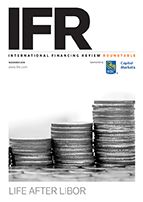It is now very clear that UK and US regulators want market participants to transition away from Libor by its phase-out at the end of 2021, predominantly because it is a not based on transactions whereas replacements SOFR and Sonia are.
Despite the US being the centre of global finance a surprising amount of action is happening in the UK’s Sonia market. It feels somehow appropriate that new issuance of Sonia-linked bonds has set a blistering pace; an endorsement that the sterling market’s designated new risk-free rate (RFR) is ready to replace Libor in a couple of years’ time.
Not only does London lend its name to the financial benchmark that underpins trillions of dollars of risk but the Bank of England and the UK’s Financial Conduct Authority have pushed hardest for this reimagining of this key piece of financial market infrastruture.
Within the primary sphere the sterling market’s transition is almost complete, spurred by the FCA’s stern urging to banks’ chief executives to get on with it.
After the initial steps were made by supranational issuers, UK banks joined the bandwagon and a pattern of steady deliberate progress emerged. Soon there was a clear framwork around how things like coupons are calculated and when payments will be made on plain-vanilla senior unsecured bonds, before the market moved into the covered bond realm and then securitisation.
From a standing start, Sonia-linked paper has boomed within 18 months and accounts for around one-fifth of all sterling issuance this year, compared with around 5% that Libor-linked floating-rate note supply would be in a typical year.
None of the new RFRs have a term structure - something that all users found a highly useful characteristic of Libor products.
Nonetheless the fact that overnight Sonia is a longstanding product in the sterling market has certainly helped its adoption.
The same cannot be said of the US where the RFR is a completely new product, an overnight secured rate, and market participants have jostled one another on methodology for new issuance.
Moreover, sharp volatility seen after summer in SOFR alongside the US repo rate truly rocked confidence.
That said, liquidity is steadily building in SOFR-based futures contracts, and to a lesser extent, Sonia futures. This type of activity suggests that a new ecosystem for price discovery and risk transfer at the short-end is being successfully created.
Legacy positions and contracts still need to be addressed. There has been some very successful liability management exercises that point to an acceptance by some players that this needs to be tackled together.
But market-led solutions might not work in certain circumstances or all jurisdictions - particularly the US.
What this means for end-users is uncertain because it is not clear what happens to Libor, and many users are still holding out for a replacement term rate. This will be forthcoming at some point but regulators seemingly want them used sparingly lest they end up with a similar situation to now - an inverted pyramid of risk atop a little-traded instrument.
All we know is that panel banks will continue to submit until the end of 2021 but after that point everyone is in the dark.
Read the roundtable here.
Biographies of the participants can be found here.
To see the digital version of this roundtable, please click here.
To purchase printed copies or a PDF of this report, please email gloria.balbastro@refinitiv.com

